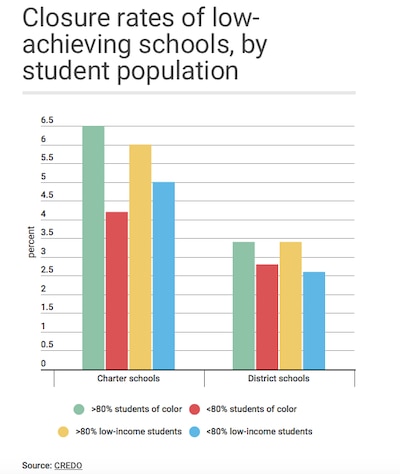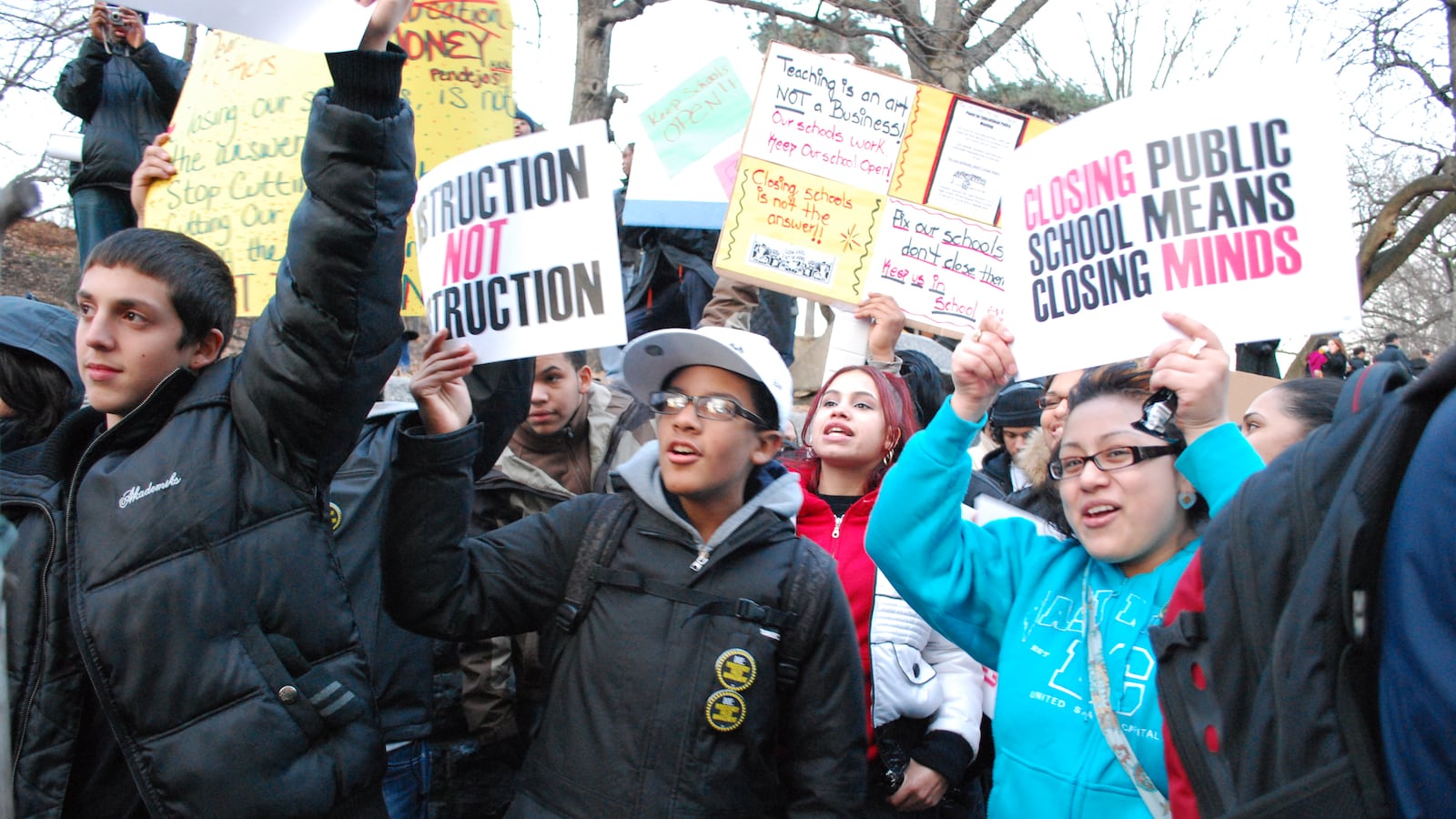Shutting down schools with low test scores doesn’t help student learning and disproportionately affects students of color, according to one of the largest studies ever of school closures.
The results, released Thursday by the Stanford-based group CREDO, indicate that closing a school doesn’t help student achievement as much as advocates have hoped — or harm it as much as some have feared.
The findings, the researchers write, “call for caution in implementing this bold policy measure.”
The study examines school closures in 26 states, from 2006 to 2013. Shuttering schools — both for financial and performance reasons — has become a common, contested phenomenon in a number of cities. High-profile education leaders like Joel Klein in New York City and John White in Louisiana have pushed school closures as a necessary, even moral, response to low performance.
Here are four things we learned from the report.
1. Closures don’t help (or substantially hurt) student achievement on average.
Overall, being displaced from a low-performing school had virtually no effect on student test scores. This undercuts rhetoric that closing “failing” schools will help students, as well as that it will dramatically harm their academic trajectories.
One caveat is that the study defines low performance of schools using absolute test scores — not how much a school’s students improve, a metric most researchers say is better for measuring school quality. Past studies in New Orleans and Ohio have found closures based on academic growth do help student learning.
Another caution is that it’s unclear just how similar the schools being compared to one another actually are. The researchers compare displaced students’ performance to students in low-achieving schools that were not shut down. If the low-scoring schools that remained open were on a more positive trajectory or had just hired a dynamic new principal, for example, that might skew the comparison.
2. When students move to higher-achieving schools they do better, but when they switch to similar schools they do worse.
Unsurprisingly, students who switched from a lower-achieving school that closed to a significantly higher achieving school — about half of the displaced students — saw their scores improve, relative to similar students whose schools weren’t closed. This is consistent with common sense and past research.
However, switching to a similarly achieving school caused a decline in test scores, perhaps because of the disruption of moving schools.
And switching to a school with lower test scores led to even bigger drops in achievement. This was relatively rare, though — in part because few schools had significantly worse test scores than the ones that closed.
3. Schools that serve more black and Hispanic students are more likely to be shut down.

Critics of school closures have long argued that they disproportionately impact — even target — black and Hispanic communities. The latest research gives some credence to this view.
It shows that schools serving a larger share of students of color were somewhat more likely to be shut down than schools with fewer students of color and similar achievement. There was also some evidence that higher poverty schools were more likely to be closed.
4. Lower-achieving charter schools are more likely to close than traditional public schools.
The study finds that 5.5 percent of low-scoring charter schools were closed down from 2006 to 2013, as compared to 3.2 percent of district schools.
One notable exception: Michigan. U.S. Secretary of Education Betsy DeVos has argued that traditional schools there lack accountability because, she said, none has ever been closed for low performance. But many have shut down, presumably for other reasons. In the time period studied, 9 percent of low-achieving Michigan district schools were shuttered, compared to less than 6 percent of low-scoring charter schools.
Four key questions the study doesn’t answer:
1. Why do low-achieving schools with more students of color close more often?
One explanation is simple: racism and lack of political power. School closures are controversial and often draw serious opposition. Students and families of color may be less successful in opposing closures if policymakers are less sympathetic to their claims.
The National Association of Charter School Authorizers, which advocates for closing persistently low-performing charters, implicitly acknowledged that possibility.
“We are especially troubled by the report’s observation of different school closure patterns based on race, ethnicity, and poverty,” president Greg Richmond said in a statement. “These differences were present among both charter schools and traditional public schools and serve as a wake-up call to examine our practices to ensure all schools and students are being treated equitably.”
But the study can’t explain why closures happen more often in certain communities. For instance, if low-achieving schools with many white students are especially likely to be located in rural areas where there are fewer alternative schools, that may help explain the results.
Another explanation could be that the expansion of charter schools in high-minority areas puts additional fiscal and enrollment pressure on districts and charters — as charters expand, other schools may close as their enrollment declines.
What is clear, though, is that black and low-income students and communities are especially likely to have a school closed.
2. How do school closures affect the students who would have gone on to attend schools that were shut down?
The study examined students who were directly affected by closures, not future students who might have otherwise attended a closed school. In one of the only studies to examine this question, those “future” students who would have otherwise attended a closed school were significantly more likely to graduate high school.
3. How do school closures affect things other than test scores?
The latest study only looks at test scores. But critics argue that shuttering a school negatively affects a community, economically and socially, and harms students in ways beyond academic achievement. Some past studies have examined student attendance, high school graduation, and college enrollment, generally showing mixed results.
4. How do school closures affect students at receiving schools?
The CREDO report doesn’t look at how an influx of new students affect the new schools they move to. Past studies have found evidence that receiving schools see a dip in student achievement as a result. This points to potential unintended consequence of closures, even when the directly affected students benefit.
This story has been updated to clarify that the effects on achievement were estimated by comparing students in closed schools to similar students at schools that were not closed.


